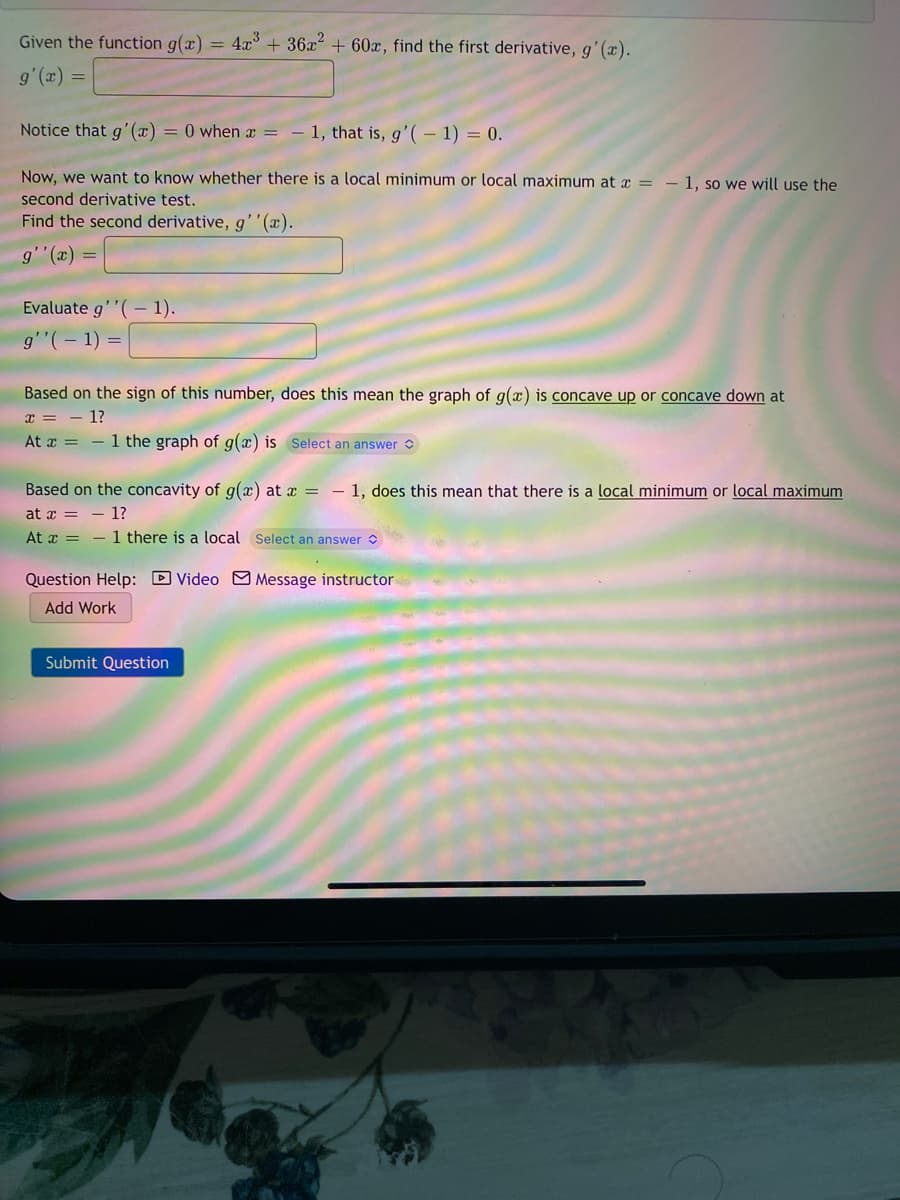Given the function g(x) = 4x° + 36x + 60x, find the first derivative, g' (x). %3D = (2),6 Notice that g'(x) = 0 when r = – 1, that is, g'(- 1) = 0. %3D Now, we want to know whether there is a local minimum or local maximum at a = - 1, so we will use the second derivative test. Find the second derivative, g''(x). %3D (a), ,6 Evaluate g''(- 1). g'"(-1) = Based on the sign of this number, does this mean the graph of g(x) is concave up or concave down at x = - 1? At x = - 1 the graph of g(x) is Select an answer o Based on the concavity of g(x) at x = – 1, does this mean that there is a local minimum or local maximum at x = - 1? At x = -1 there is a local Select an answer
Given the function g(x) = 4x° + 36x + 60x, find the first derivative, g' (x). %3D = (2),6 Notice that g'(x) = 0 when r = – 1, that is, g'(- 1) = 0. %3D Now, we want to know whether there is a local minimum or local maximum at a = - 1, so we will use the second derivative test. Find the second derivative, g''(x). %3D (a), ,6 Evaluate g''(- 1). g'"(-1) = Based on the sign of this number, does this mean the graph of g(x) is concave up or concave down at x = - 1? At x = - 1 the graph of g(x) is Select an answer o Based on the concavity of g(x) at x = – 1, does this mean that there is a local minimum or local maximum at x = - 1? At x = -1 there is a local Select an answer
Calculus: Early Transcendentals
8th Edition
ISBN:9781285741550
Author:James Stewart
Publisher:James Stewart
Chapter1: Functions And Models
Section: Chapter Questions
Problem 1RCC: (a) What is a function? What are its domain and range? (b) What is the graph of a function? (c) How...
Related questions
Question
100%
13

Transcribed Image Text:Given the function g(x)
= 4x° + 3672
+ 60x, find the first derivative, g'(x).
g'(x) =
Notice that g'(x) = 0 when x = – 1, that is, g'( – 1) = 0.
Now, we want to know whether there is a local minimum or local maximum at x = – 1, so we will use the
second derivative test.
Find the second derivative, g''(x).
g''(x) =
Evaluate g''(- 1).
g''(– 1) =
Based on the sign of this number, does this mean the graph of g(x) is concave up or concave down at
x = - 1?
At x = - 1 the graph of g(x) is Select an answer
Based on the concavity of g(x) at x = – 1, does this mean that there is a local minimum or local maximum
at x = - 1?
At x =
1 there is a local Select an answer O
Question Help: D Video M Message instructor
Add Work
Submit Question
Expert Solution
This question has been solved!
Explore an expertly crafted, step-by-step solution for a thorough understanding of key concepts.
Step by step
Solved in 2 steps with 2 images

Recommended textbooks for you

Calculus: Early Transcendentals
Calculus
ISBN:
9781285741550
Author:
James Stewart
Publisher:
Cengage Learning

Thomas' Calculus (14th Edition)
Calculus
ISBN:
9780134438986
Author:
Joel R. Hass, Christopher E. Heil, Maurice D. Weir
Publisher:
PEARSON

Calculus: Early Transcendentals (3rd Edition)
Calculus
ISBN:
9780134763644
Author:
William L. Briggs, Lyle Cochran, Bernard Gillett, Eric Schulz
Publisher:
PEARSON

Calculus: Early Transcendentals
Calculus
ISBN:
9781285741550
Author:
James Stewart
Publisher:
Cengage Learning

Thomas' Calculus (14th Edition)
Calculus
ISBN:
9780134438986
Author:
Joel R. Hass, Christopher E. Heil, Maurice D. Weir
Publisher:
PEARSON

Calculus: Early Transcendentals (3rd Edition)
Calculus
ISBN:
9780134763644
Author:
William L. Briggs, Lyle Cochran, Bernard Gillett, Eric Schulz
Publisher:
PEARSON

Calculus: Early Transcendentals
Calculus
ISBN:
9781319050740
Author:
Jon Rogawski, Colin Adams, Robert Franzosa
Publisher:
W. H. Freeman


Calculus: Early Transcendental Functions
Calculus
ISBN:
9781337552516
Author:
Ron Larson, Bruce H. Edwards
Publisher:
Cengage Learning